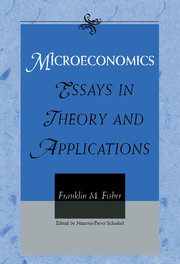Book contents
- Frontmatter
- Contents
- Introduction
- Part I Disequilibrium and Stability
- Part II Welfare Economics and Consumer Theory
- Part III Applications of Microeconomic Theory
- Part IV Industrial Organization, Economics, and the Law
- 24 Organizing Industrial Organization: Reflections on the Handbook of Industrial Organization (1991)
- 25 Reflections on Competition Policy (1993)
- 26 The Social Costs of Monopoly and Regulation: Posner Reconsidered (1985)
- 27 Due Diligence and the Demand for Electricity: A Cautionary Tale (1992)
- 28 Estimating the Effects of Display Bias in Computer Reservation Systems (1990)
- Part V Public Policy Applications
- Epilogue
- Indexes
28 - Estimating the Effects of Display Bias in Computer Reservation Systems (1990)
Published online by Cambridge University Press: 20 March 2010
- Frontmatter
- Contents
- Introduction
- Part I Disequilibrium and Stability
- Part II Welfare Economics and Consumer Theory
- Part III Applications of Microeconomic Theory
- Part IV Industrial Organization, Economics, and the Law
- 24 Organizing Industrial Organization: Reflections on the Handbook of Industrial Organization (1991)
- 25 Reflections on Competition Policy (1993)
- 26 The Social Costs of Monopoly and Regulation: Posner Reconsidered (1985)
- 27 Due Diligence and the Demand for Electricity: A Cautionary Tale (1992)
- 28 Estimating the Effects of Display Bias in Computer Reservation Systems (1990)
- Part V Public Policy Applications
- Epilogue
- Indexes
Summary
Introduction
Today, the majority of airline reservations are made and tickets are sold through computer reservation systems (CRSs). The history of these systems, however, has been one of continuous controversy, involving both regulatory and antitrust proceedings. This paper is drawn from our work in one of those proceedings, the antitrust suit brought by Continental Airlines (and its associated corporate family) against American Airlines and United Airlines. Our work focused on the so-called bias period – before the Civil Aeronautics Board (CAB) issued its CRS Rules in 1984 (see C.F.R., 1984). The history and issues involved are recounted briefly below.
Computer reservation systems grew out of the internal reservation systems of the airlines. In the mid-1970s, there was discussion of extending the advancing reservation and information technology to travel agencies. This discussion resulted in the formation of an industry committee, a joint development that soon came to naught, however, when United Airlines and American Airlines pulled out of the committee and each announced it would develop its own system. With the withdrawal of the two largest domestic airlines and (and – not coincidentally – the two with the best-developed internal reservations systems), cooperative development effectively stopped.
Deregulation of the airline industry created powerful incentives for United and American to develop their own proprietary systems. As new carriers began operations and established carriers entered new routes, the number of different flights and itineraries that might suit a particular customer's request could become very large.
- Type
- Chapter
- Information
- MicroeconomicsEssays in Theory and Applications, pp. 450 - 484Publisher: Cambridge University PressPrint publication year: 1999



